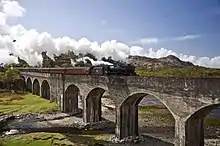Loch nan Uamh Viaduct
The Loch nan Uamh Viaduct is a railway viaduct that carries the West Highland Line.
Loch nan Uamh Viaduct | |
|---|---|
 The viaduct carrying The Jacobite | |
| Coordinates | 56.8923382°N 5.7306558°W |
| Carries | West Highland Line |
| Crosses | Allt a' Mhama |
| Characteristics | |
| Material | Concrete |
| Longest span | 50 feet (15 m) |
| No. of spans | 8 |
| History | |
| Engineering design by | Simpson & Wilson |
| Construction start | 1897 |
| Opened | 1901 |
| Location | |

| |
History
The West Highland Railway was built to Fort William by Lucas and Aird, but there were delays with the West Highland Railway Mallaig Extension (Guarantee) bill for the Mallaig Extension Railway in the House of Commons as the Tory and Liberal parties fought over the issue of subsidies for public transport. This Act did pass in 1896, by which time Lucas & Aird (and their workers) had moved south.[1] New contractors were needed and Robert McAlpine & Sons were taken on with Simpson & Wilson as engineers. Robert McAlpine & Sons was headed by Robert McAlpine, nicknamed "Concrete Bob" for his innovative use of mass concrete.[2] Concrete was used due to the difficulty of working the hard schist in the area.[3] McAlpine's son Robert, then aged 28, took charge of construction, with his younger son Malcolm appointed as assistant.[4]
Construction of the extension from Fort William to Mallaig began in January 1897, and the line opened on 1 April 1901.[5][6]
Design
The viaduct has eight concrete arches of 50 feet (15 m) span, four each side of a large central concrete pylon.[7] The reason for this design is not known.[7]
The viaduct crosses the Allt a' Mhama, or Mama Burn, just before it flows into Loch nan Uamh, a sea loch to the north of the Ardnish peninsula.[8][9]
Immediately to the north of the viaduct is a short tunnel.[9][10]
Entombed horse
In 1987 Roland Paxton, from Heriot-Watt University, investigated the legend that a horse had fallen into a pier during construction of Glenfinnan Viaduct in 1898 or 1899.[11][12] However, after inserting a fisheye camera into boreholes made into the only two piers large enough to accommodate a horse, no animal remains were found.[12] In 1997, on the basis of local hearsay, Paxton investigated Loch nan Uamh viaduct using the same method but found only rubble as well.[11][12] In 2001, he returned to Loch nan Uamh with radar equipment and found the remains of a horse and cart within the viaduct's central pylon.[7][12]
References
- Thomas 1971, pp. 92-95
- Miers, Mary (2008). The Western Seaboard: An Illustrated Architectural Guide. Rutland Press. ISBN 978-1-873190-29-6.
- Paxton, Roland; Shipway, J. (2007). Civil Engineering Heritage Scotland: Highlands and islands. Thomas Telford. pp. 186–187. ISBN 978-0-7277-3488-4.
- Thomas 1971, pp. 95-96
- Thomas 1971, pp. 177-178
- Awdry, Christopher (1990). Encyclopaedia of British Railway Companies. Sparkford: Patrick Stephens Ltd. p. 169. ISBN 1-8526-0049-7. OCLC 19514063. CN 8983.
- "Loch Nan Uamh Viaduct". rcahms.gov.uk. Retrieved 30 December 2014.
- "Mama Burn, Bridge". rcahms.gov.uk. Retrieved 30 December 2014.
- Google (30 December 2014). "Loch nan Uamh Viaduct" (Map). Google Maps. Google. Retrieved 30 December 2014.
- "Loch Nan Uamh Viaduct". scotlandsplaces.gov.uk. Retrieved 30 December 2014.
- "Jim Shipway". The Herald. 23 August 2013. Archived from the original on 24 September 2015. Retrieved 1 January 2015 – via Highbeam.
- "The Horse in the Viaduct - a tale of Victorian engineering". moidart.org.uk. Retrieved 1 January 2015.
Sources
- Thomas, John (1971). The West Highland Railway. Pan Books. ISBN 0-330-02479-5.CS1 maint: ref=harv (link)
External links
| Wikimedia Commons has media related to Loch nan Uamh Viaduct. |